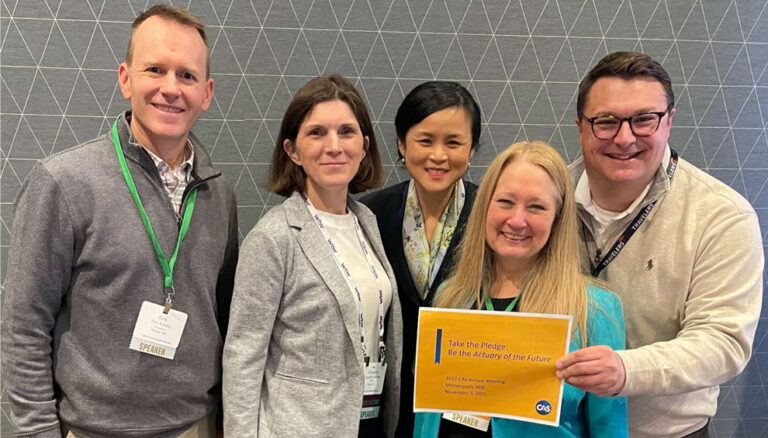
It all began with Jessica Leong’s Presidential Address at the 2021 CAS Annual Meeting in San Diego (see IMO, AR January/February 2022). Leong, CEO of Octagram, challenged CAS members to pledge to be actuaries of the future, asking that they apply their analytical skills to solve business problems with quantifiable outcomes. She invited members to commit to this goal and be able tell the stories of their impacts on business.
A year later, Leong came together with a panel of actuaries responsible for hiring and developing other actuaries. The panel told their own stories and learned from each other and the audience in “Take the Pledge — Be An Actuary of the Future.” Stemming from the CAS Strategic Plan, the pledge’s goal is for actuaries to commit to being analytic problem solvers.
The audience for this well-attended session, held November 7, 2022, at the CAS Annual Meeting, was a diverse group of new and established actuaries as well as several students participating in the CAS Annual Meeting through the Student Central Ambassador Program.
Panelists shared stories of persuasion or incremental changes having big impacts and of concentrated focus on understanding the business. Common amongst all the anecdotes were the values of listening, communication and knowledge.
Alejandra Nolibos, a senior director with WTW, has been a consultant for over 20 years, and worked on a wide variety of actuarial and business problems over that time. She concludes that “the profession can contribute much when we focus on solving business problems instead of ‘keeping score.’” She told the story of an appreciative underwriter complimenting an actuary by saying, “You see things I don’t see!”
Julia Stenberg, vice president and actuary with CNA Insurance Companies, stressed that actuaries should seek to understand business partner “pain points” rather than performing reviews without that feedback. Often issues can be resolved quickly with a small amount of actuarial resources, building trust and improving profitability. Stenberg wished that she had figured this out earlier in her career.
For moderator Wesley Griffiths, assistant vice president, actuarial & analytics for Travelers, actuaries tend to “stay in their lane too much.” Panelist Eric Kendig, also an assistant vice president, actuarial & analytics for Travelers, echoed his sentiment and articulated three ways actuaries can expand their knowledge and make greater use of their distinctive toolkits:
- Have complete knowledge of how products go to market.
- Explore using nontraditional data sources to help price business. Also, what can you learn about the reasons why a piece of business wasn’t written?
- Determine if more modeling can be done. A pricing actuary can help to make the model better with their deep understanding of the business.
Leong advised that you should always frame your work based on the business value you are providing. For example, you aren’t doing a rate review, you’re ensuring that the premiums charged are adequate. Stenberg suggested being open to feedback and digging a little deeper to identify business partner concerns and to understand their resistance to your work. When an underwriter tells you that your indications are too high, ask questions to understand why — you may find a key assumption is not correct. Updating your review for new assumptions — and disclosing it — builds trust and influence.
Following the stories, the interactive part of the program began with the audience discussing and brainstorming ideas on how to be an actuary of the future. The following are some of the suggestions:
- Determine when good is good enough. (Managers: Learn how to convey that to your employees.) In other words, let go of perfect.
- “Understand other people’s ‘lanes,’” as opposed to “staying in your lane” (attributed to Akshay Mandalia, FCAS, of WTW and Griffiths).
- Implement a pilot group to “test and learn” what works.
- Be task-oriented or offer-focused when discussing the job with a client, i.e., “What am I offering?”
- Use the 80/20 rule when there’s a time crunch problem — identify what needs to be done first to get the most impact.
- Be transparent and open to peer review.
- Evolve with the world. Be more adaptive.
- Act as if you are interviewing. Know the business.
- Develop holistic answers that give alternatives with different projections. Listen to what they are really asking you.
- Propose at least two solutions to a problem.
- Understand the “languages” of other businesses.
- Automate as much as possible.
The session ended with the panel encouraging the audience to consider the ideas proposed that day and to pledge to be actuaries of the future.
Do you want to be the actuary of the future, and help advance the CAS and actuarial profession? If you do, then be proactive — read more and sign up for the pledge on the CAS website.













